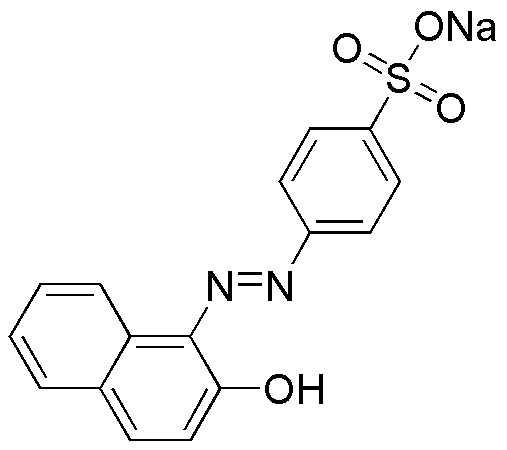Orange II is widely utilized in research focused on:
- Dyeing and Textile Industry: This compound is commonly used as a dye for textiles, providing vibrant color and excellent fastness properties, making it ideal for fabrics that require durability.
- Biological Staining: In microbiology and histology, Orange II serves as a staining agent, helping researchers visualize cells and tissues under a microscope, which is crucial for diagnostics and research.
- Food Industry: As a food colorant, it enhances the visual appeal of various products. Its use is regulated, ensuring safety while providing a bright, attractive color.
- Analytical Chemistry: This compound is employed in spectrophotometric analysis, allowing for the quantification of substances in solution, which is essential for quality control in various industries.
- Environmental Monitoring: Orange II is used in studies assessing water pollution, as it can indicate the presence of contaminants, helping industries comply with environmental regulations.
General Information
Properties
Safety and Regulations
Applications
Orange II is widely utilized in research focused on:
- Dyeing and Textile Industry: This compound is commonly used as a dye for textiles, providing vibrant color and excellent fastness properties, making it ideal for fabrics that require durability.
- Biological Staining: In microbiology and histology, Orange II serves as a staining agent, helping researchers visualize cells and tissues under a microscope, which is crucial for diagnostics and research.
- Food Industry: As a food colorant, it enhances the visual appeal of various products. Its use is regulated, ensuring safety while providing a bright, attractive color.
- Analytical Chemistry: This compound is employed in spectrophotometric analysis, allowing for the quantification of substances in solution, which is essential for quality control in various industries.
- Environmental Monitoring: Orange II is used in studies assessing water pollution, as it can indicate the presence of contaminants, helping industries comply with environmental regulations.
Documents
Safety Data Sheets (SDS)
The SDS provides comprehensive safety information on handling, storage, and disposal of the product.
Product Specification (PS)
The PS provides a comprehensive breakdown of the product’s properties, including chemical composition, physical state, purity, and storage requirements. It also details acceptable quality ranges and the product's intended applications.
Certificates of Analysis (COA)
Search for Certificates of Analysis (COA) by entering the products Lot Number. Lot and Batch Numbers can be found on a product’s label following the words ‘Lot’ or ‘Batch’.
*Catalog Number
*Lot Number
Certificates Of Origin (COO)
This COO confirms the country where the product was manufactured, and also details the materials and components used in it and whether it is derived from natural, synthetic, or other specific sources. This certificate may be required for customs, trade, and regulatory compliance.
*Catalog Number
*Lot Number
Safety Data Sheets (SDS)
The SDS provides comprehensive safety information on handling, storage, and disposal of the product.
DownloadProduct Specification (PS)
The PS provides a comprehensive breakdown of the product’s properties, including chemical composition, physical state, purity, and storage requirements. It also details acceptable quality ranges and the product's intended applications.
DownloadCertificates of Analysis (COA)
Search for Certificates of Analysis (COA) by entering the products Lot Number. Lot and Batch Numbers can be found on a product’s label following the words ‘Lot’ or ‘Batch’.
*Catalog Number
*Lot Number
Certificates Of Origin (COO)
This COO confirms the country where the product was manufactured, and also details the materials and components used in it and whether it is derived from natural, synthetic, or other specific sources. This certificate may be required for customs, trade, and regulatory compliance.


